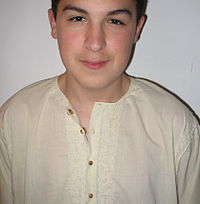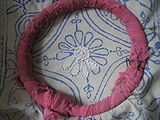- Chikan (embroidery)
-
 Chikan embroidery on a cotton kurta
Chikan embroidery on a cotton kurta
Chikan (Hindi: चिकन, Urdu: چکن) is a traditional embroidery style from Lucknow, India. Literally translated, the word means embroidery. Believed to have been introduced by Nur Jehan, Mughal emperor Jahangir's wife,[1] it is one of Lucknow's most famous textile decoration styles.
Contents
Origin
Chikankari (process of chikan) was basically invented in Lucknow (India). It developed quickly during the Mughal period and consisted of style inspired by Persians. Lucknow in India grew into a international market for this incredible style. Today it is popular in many countries.
Overview
Chikan began as a type of white-on-white (or whitework) embroidery.
Technique
Creation of a chikan work (chikankari चिकनकारी چکن کاری) piece begins with the use of one or more pattern blocks that are used to block-print a pattern on the ground fabric. The embroiderer then stitches the pattern, and the finished piece is carefully washed to remove all traces of the printed pattern.[2]
The patterns and effects created depend on the types of stitches and the thicknesses of the threads used in the embroidery. Some of the varieties of stitches used include backstitch, chain stitch and hemstitch. The result is an open work pattern, jali (lace) or shadow-work. Often the embroiderer creates mesh-like sections in the design by using a needle to separate threads in the ground fabric, and then working around the spaces.[2]
I would like to add a little detail on Chikankari ,it consists of 32 different Stitches in which the major stitches are called in native Hindi language as "Bakhiya" "Fanda" "Murri" "Bijli" "Pechni" "Ghans patti" "Ulti Jali".
Further reading
- Romancing With Chikankari by Veena Singh
- Paine, Sheila (1989). Chikan embroidery: the floral whitework of India. Shire Publications. ISBN 074780009X.
References
- ^ Wilkinson-Weber, Clare M. (1999). 5. Skill and Knowledge in Fine Chikan Embroidery, Embroidering Lives: Women's Work and Skill in the Lucknow Embroidery Industry, pp. 12-13. State University of New York Press. ISBN 0791440877.
- ^ a b Dusenbury, Mary M. (2004). Flowers, Dragons and Pine Trees: Asian Textiles in the Spencer Museum of Art, p. 42. Hudson Hills Press. ISBN 1555952380.
External links
Categories:- Embroidery in India
- Lucknow culture
- Culture of Uttar Pradesh
- Indian culture stubs
- Textile arts stubs
Wikimedia Foundation. 2010.





